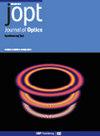Bit error rate of M-pulse position modulated laser beams for vertical links operating in weak oceanic turbulence
IF 2.7
4区 物理与天体物理
Q3 OPTICS
引用次数: 0
Abstract
The on-axis scintillation index of laser beams is investigated by employing the Rytov method in a weakly turbulent oceanic medium for up/downlink coupling of laser communication between any underwater vehicles or divers. For vertical links, the formulation of the on-axis scintillation index of laser beams is derived analytically and evaluated for plane, collimated Gaussian and spherical beams in specific mediums, including the Atlantic Ocean at mid and low latitudes associating temperature and salinity changes at low latitudes, at mid latitude-summer and at mid latitude-winter. Using the scintillation index, bit error rate (BER) performance of M-pulse position modulation is investigated for these types of laser beams. The variations of the scintillation index against the uplink/downlink propagation distances, source size and zenith angle are examined, and BER variations versus the Kolmogorov microscale and the symbol orders, and results are compared. It is noted that the behavior of the scintillation index that depends on the relative strength of temperature and salinity fluctuations which changes in depth, is different for uplink/downlink and for each latitude due to its distinct characteristics. The source size that minimizes the scintillation index values is in the range of about 0.1 cm–0.2 cm for all latitudes.用于在弱海洋湍流中运行的垂直链路的 M 脉冲位置调制激光束的比特误差率
通过在弱湍流海洋介质中采用 Rytov 方法研究了激光光束的轴向闪烁指数,用于任何水下航行器或潜水员之间激光通信的上/下行链路耦合。对于垂直链路,分析得出了激光光束的轴向闪烁指数,并对特定介质中的平面光束、准直高斯光束和球形光束进行了评估,包括中低纬度的大西洋,以及低纬度、中纬度-夏季和中纬度-冬季的温度和盐度变化。利用闪烁指数,研究了这些类型激光束的 M 脉冲位置调制的误码率(BER)性能。研究了闪烁指数随上行链路/下行链路传播距离、光源大小和天顶角的变化,以及误码率随科尔莫哥洛夫微尺度和符号阶数的变化,并对结果进行了比较。我们注意到,闪烁指数的行为取决于随深度变化的温度和盐度波动的相对强度,而上行链路/下行链路和每个纬度的闪烁指数因其不同的特性而各不相同。在所有纬度上,使闪烁指数值最小的光源尺寸范围约为 0.1 厘米-0.2 厘米。
本文章由计算机程序翻译,如有差异,请以英文原文为准。
求助全文
约1分钟内获得全文
求助全文
来源期刊

Journal of Optics
OPTICS-
CiteScore
4.50
自引率
4.80%
发文量
237
审稿时长
1.9 months
期刊介绍:
Journal of Optics publishes new experimental and theoretical research across all areas of pure and applied optics, both modern and classical. Research areas are categorised as:
Nanophotonics and plasmonics
Metamaterials and structured photonic materials
Quantum photonics
Biophotonics
Light-matter interactions
Nonlinear and ultrafast optics
Propagation, diffraction and scattering
Optical communication
Integrated optics
Photovoltaics and energy harvesting
We discourage incremental advances, purely numerical simulations without any validation, or research without a strong optics advance, e.g. computer algorithms applied to optical and imaging processes, equipment designs or material fabrication.
 求助内容:
求助内容: 应助结果提醒方式:
应助结果提醒方式:


